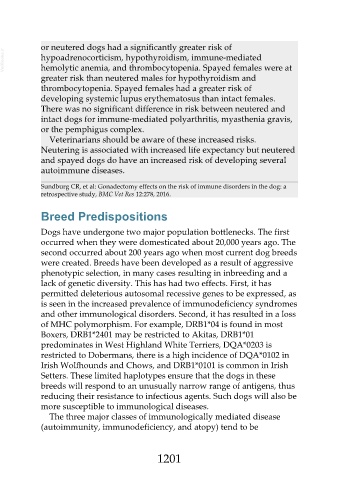Page 1201 - Veterinary Immunology, 10th Edition
P. 1201
or neutered dogs had a significantly greater risk of
VetBooks.ir hypoadrenocorticism, hypothyroidism, immune-mediated
hemolytic anemia, and thrombocytopenia. Spayed females were at
greater risk than neutered males for hypothyroidism and
thrombocytopenia. Spayed females had a greater risk of
developing systemic lupus erythematosus than intact females.
There was no significant difference in risk between neutered and
intact dogs for immune-mediated polyarthritis, myasthenia gravis,
or the pemphigus complex.
Veterinarians should be aware of these increased risks.
Neutering is associated with increased life expectancy but neutered
and spayed dogs do have an increased risk of developing several
autoimmune diseases.
Sundburg CR, et al: Gonadectomy effects on the risk of immune disorders in the dog: a
retrospective study, BMC Vet Res 12:278, 2016.
Breed Predispositions
Dogs have undergone two major population bottlenecks. The first
occurred when they were domesticated about 20,000 years ago. The
second occurred about 200 years ago when most current dog breeds
were created. Breeds have been developed as a result of aggressive
phenotypic selection, in many cases resulting in inbreeding and a
lack of genetic diversity. This has had two effects. First, it has
permitted deleterious autosomal recessive genes to be expressed, as
is seen in the increased prevalence of immunodeficiency syndromes
and other immunological disorders. Second, it has resulted in a loss
of MHC polymorphism. For example, DRB1*04 is found in most
Boxers, DRB1*2401 may be restricted to Akitas, DRB1*01
predominates in West Highland White Terriers, DQA*0203 is
restricted to Dobermans, there is a high incidence of DQA*0102 in
Irish Wolfhounds and Chows, and DRB1*0101 is common in Irish
Setters. These limited haplotypes ensure that the dogs in these
breeds will respond to an unusually narrow range of antigens, thus
reducing their resistance to infectious agents. Such dogs will also be
more susceptible to immunological diseases.
The three major classes of immunologically mediated disease
(autoimmunity, immunodeficiency, and atopy) tend to be
1201

